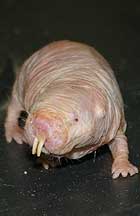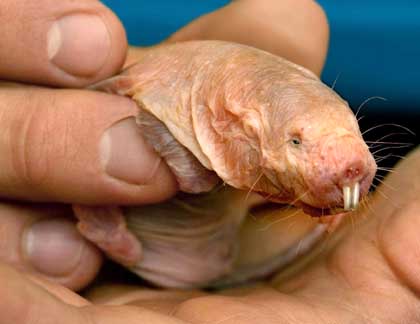
Naked mole-rat, close-up
Photo: Paul Thomson
Back to the Homepage – Hans-Georg Michna
Naked Mole-rats
in Meru, Kenya
Last change: 2005-11-21
See www.nakedmolerat.com for more info on these animals.
When I went to Kenya in June 1996, that time all by myself, I decided on the fly to visit one more remote reservation area, Meru National Park, a bit out of the way for most tourists, not developed, one now decrepit lodge (Meru Mulika), a bunch of self-help bandas (huts) in ruins (Leopard Rock), but one well-working camp site, even with three bandas. I rented one of them and went out to see the area.
Driving through the nature reserve in the late afternoon, I suddenly saw a shaggy Land Rover parked on the road, a small white man with a full beard and his Kenyan assistant. They had something like a miniature tent built up right in the middle of the dirt road and were apparently watching it.
I drove closer, but the man waved me through very determinedly, indicating that I was disturbing whatever they were doing.
I drove past, giving the tiny tent a puzzled look, but went on to see some animals like the rare Lesser Kudu, of which I caught a nice glimpse. Too little light for a photograph, because it was already evening, and the sun sets not long after 6 pm under the equator.
I drove back to the camp site and met a bunch of English zoology students who were on a field trip through Kenya, studying the variety of environments. I spent some time with them, then I saw the same Land Rover again, standing beside the next banda. Curious, I went over and met the bearded man again. I asked him what he had been doing on that road. Without a word, he waved me into his banda and walked to a large metal chest, from which I could hear scratching noises. He opened the lid, and I stared at a whole heap of over a hundred little crawling potatos with four legs, a little tail and four big teeth each. They had no eyes, just a dark mark where the eyes would normally be.

Naked mole-rat, close-up
Photo: Paul Thomson
Sure enough, this was the east African variety of the Naked Mole-rat. He then introduced himself as Stan Braude from the University of Michigan and was friendly enough to tell me, and later some of the zoology students, quite a bit about these strange animals.
He was in the process of emptying one colony with an estimated 120 individuals entirely. He trapped them with a tubular, mechanical trap after baiting them with a sweet potato the night before. The reason he had to catch all of them is that the last one is usually the queen. She doesn’t appear, as long as there’s still anybody to feed her, but after her last worker is caught, she finally appears and can get caught.
Stan was measuring and marking all individuals, but the queen is the most interesting, so he has to catch them all. After the work he releases them back into their labyrinth.

Not much bigger than a mouse
The Naked Mole Rat lives in an underground system of tunnels. Deep, meters below the surface, is the freeway system. These tunnels have been dug up by curious researchers, and their oval shape shows that millions of little feet must have used them over the course of many, many years, thereby taking small amounts of dirt with them, which very slowly changes the cross section and makes it vertically elongated and increasingly egg-shaped, rather than circular. In fact, the researchers use this, when they dig down to a freeway tunnel, to estimate the age of the tunnel.
From there upward extend the feeding areas, networks of tunnels that reach near the surface to get at roots, which is their diet. In some places the surface is reached, and a little volcano becomes visible from above. This is how Stan finds them.
Finally they have large nests, into which they retreat, where the queen breeds, where they sleep.
Stan once caught out one colony, which took a little longer. The captive animals eventually gathered in one big heap in the box where he kept them. When he finally released them again, he found some dead ones in the center of the heap. Too bad, he thought, must be more careful the next time, and threw them in a garbage can. Much to his surprise he later heard those scratching noises from the can and found them all alive and well. This is how their ability to hibernate was discovered. Perhaps they can use this ability when the rains fail and there is nothing to eat.
An interesting question is why they have this insect-like social life with only one breeding queen and only very few breeding males. Nobody knows for sure, but we do know how the queen does it. She harrasses all females and puts them under constant stress. They actually don’t ovulate.
When a new male tries to mate with her, she often tries to kill him. Stan speculates that the male strategy could be to try it once. When she agrees—good, when not, try to save your life and don’t try that again too soon.
Unlike some state building insects, they all have complete, double chromosome sets and, contrary to some recent speculation, there doesn’t seem to be any significant inbreeding. Genetic analyses are forthcoming, but research is still in the beginning.
Colonies with more than one queen have been observed. One had a queen and her daughter, who also bred.
The mole-rats do not recognize individuals by smell or some such. When you introduce foreigners into a colony, they are readily accepted. When two colonies expand into each other’s area, the animals will fight fiercely though, sometimes taking slaves. Stan speculates that it’s the situation that triggers the fighting, i.e. when a mole rat digs at the periphery of the colony tunnel system and breaks through into an existing tunnel outside, the animal will be alarmed and will fight. He speculates that when one would create a horsehoe-shaped colony and make the ends touch, they would fight each other, not noticing that they’re the same colony. We don’t know this for sure, though.
2002-05-17 – Danielle Farrar wrote: I think they found out that the mole-rats roll in their communal fecal waste pile and identify other members of their community by scent.
One of the most interesting questions is how new colonies are formed. We know that sometimes some animals leave the colony and move over large distances on the surface. One marked female was found 2 km (some more than a mile) from her colony. We can assume that many will not make it, because they’re such an easy target for owls and other hunters. But some have to make it, meet a mate and form a new, successful colony.
They have to time this, like the ants and termites do, presumably at the end of the rainy season when there’s lots of food and the soil is soft. We know from some other mole rat species (South Africa) that they have dispersion morphs, which are bigger than the average animal. We also know that in some species in Israel the female drums with her hind feet to attract a male. We don’t know that much about the East African species yet.
This is only a small fraction of what I learned in Meru. I hope some readers will find it interesting.
Hans-Georg Michna
Meru, Samburu, Buffalo Springs, altitude approx. 873 m, map datum WGS 84
1999: N0.57364 E37.55069
1999: N0.57149 E37.55382
2001: N0.55782 E37.57024
2001: N0.57406 E37.54671
2001: N0.57443 E37.54664
2001: N0.57083 E37.53943
2001: N0.56864 E37.54323
Many more in Samburu and Buffalo Springs in 2003 after prolonged rains and still in 2004, have stopped recording.
Back to the homepage – Hans-Georg Michna
hits since 2007-11-01
Free PHP scripts by PHPJunkYard.com